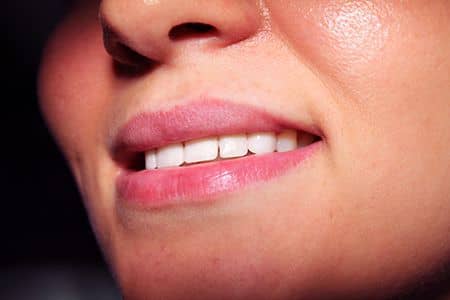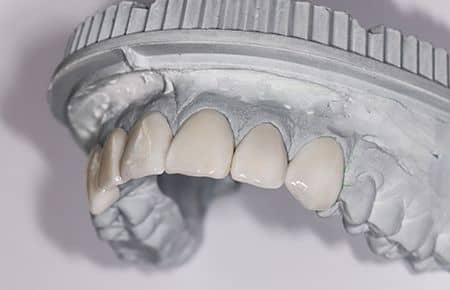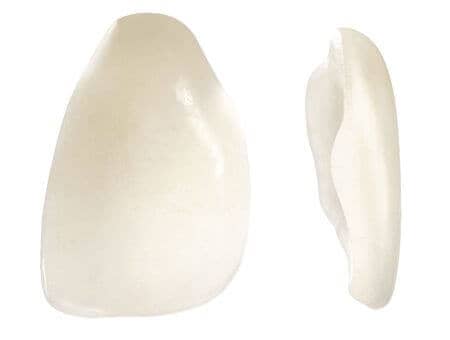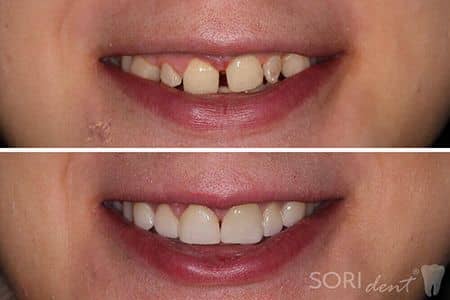Dental veneers are used in dental cosmetics, they are the most conservative solution (minimally invasive) in correcting aesthetic problems of the front teeth.
A veneer is a foil made of fine ceramic, created using the CAD-CAM System technology, which is bonded on the facial surface (outside) of the tooth using cement or light-curing adhesive composite, changing the teeth appearance, position, shape or length.

Veneering prosthesis is an alternative to using porcelain crowns, where the loss of dental tissue is higher. The life of ceramic veneers is between 5 and 10 years.
The veneering process can be done in two ways:
• With the preparation of the teeth. It is the recommended method where a drastic change in the appearance of teeth is needed. It is done by the removal of a layer of 1-2 mm of enamel on the external surface of the tooth and the sides. This method is also indicated and where we have very bulky teeth and application of veneers on them will further increase the volume.

• With no preparation or minimal preparation of the teeth. This method is indicated in the case of thinner teeth and uses 0.5 mm thick veneers. The main advantage is the preservation of dental tissue.
The veneers can be made from several types of materials:
• Full Zirconia. Extremely resistant, the veneers are only made by CAD/CAM technology. The newest and most recommended material and technique.
• Pressed ceramic. This type of veneers are quite strong, but usually thicker than others.
• Layered ceramic. Feldspathic ceramic is added layer by layer by the technician and the shape can be easily adapted to each patient.
• Lithium disilicate. Extremely strong, these veneers are only created using CAD/CAM computerized technology. The newest and most recommended material and technique.

Veneers are often used in the following cases:
• Stained, discolored or very dark teeth (either due to root canal treatment or tetracycline treatment in childhood, the presence of very old and discolored fillings or just simply due to consumption of coffee, dark tea, tobacco).
• Worn down teeth.
• Chipped or broken teeth.
• Uneven or malpositioned teeth.
• Irregularly shaped teeth.
• Gaps between teeth.
Because of the multiple veneer indications, patients can enjoy the benefits of dental whitening, restorations (crowns) and orthodontic treatment, all together in a very short time (2-3 sessions).
Dental veneers maintain their color well over time as ceramics are highly resistant to stains and nonporous.
Although the technology used and the ceramic materials that the veneers are made of are pretty expensive, they are considered a very good dental investment over time.
The treatment can boost a patient's confidence.
Veneering process is not reversible. Once the teeth are covered with veneers, they cannot return to their previous situation, you can only replace the veneers with new ones after a number of years.
As with any dental work, there is a period of accomodation with the new veneers. At first, difficulties in pronouncing certain consonants like "v", "f" or "s" may occur. Dental veneers can be adjusted later by the dentist, if necessary.
Broken or cracked tooth veneers can not be repaired. In case of a fracture, they must be replaced.
Although rare, they can fall off from the teeth. To avoid this, vicious habits such as nail biting, pen, pencils or other hard objects are forbidden. It is recommended to avoid excessive force on the teeth.
Teeth covered with veneers can still be affected by caries in areas not covered, so a very rigorous hygiene is required.
Dental veneers price is quite high.
Patients who will receive dental veneers should have a healthy periodontal tissue and a very good dental hygiene. Gum disease can even compromise the appearance of a very well done job.
A very important contraindication is the nocturnal or diurnal bruxism and the vicious habits. Bruxism or "teeth grinding", "teeth clenching" is an enemy of dental veneers because it generates very large forces on them and although they are made of porcelain that is resistant and durable, they can break or even detach completely from the surface of the teeth.
Tooth decay or untreated dental infections (tooth abscesses or granulomas) contraindicate cosmetic treatment of affected teeth. Veneers can be applied only after the prior treatment of the teeth.
Read also about the Zirconia Restorations.
To find out the price for a veneer go to our Pricelist page.


To see more of our patients please visit Clinical Cases
Last updated: November 10th, 2018